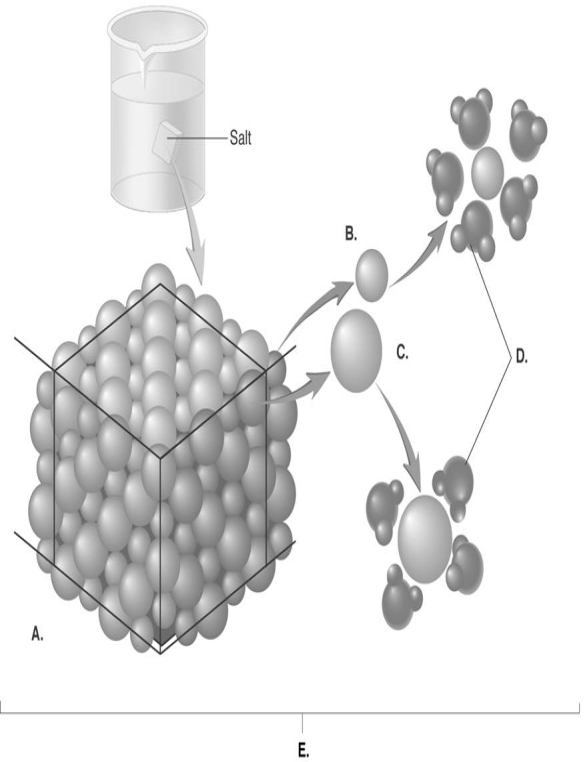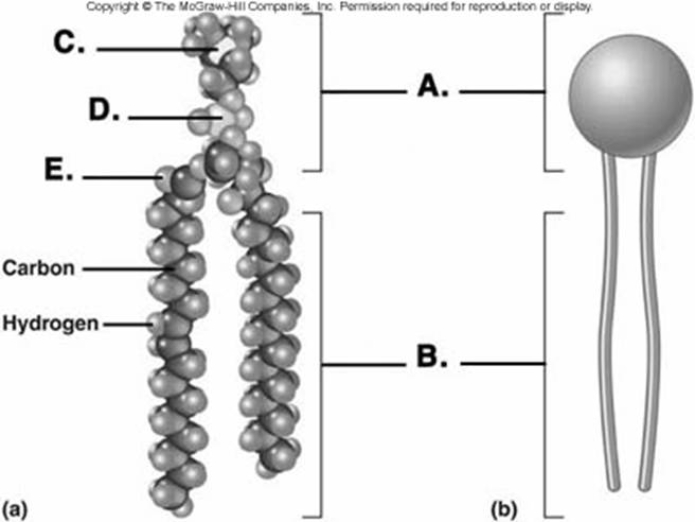A) chloride ion
B) dissociation
C) water molecule
D) sodium ion
E) salt crystal
G) A) and D)
Correct Answer

verified
Correct Answer
verified
Multiple Choice
Subatomic particles located around the nucleus of an atom are
A) protons.
B) electrons.
C) neutrons.
D) neutrinos.
E) photons.
G) A) and B)
Correct Answer

verified
Correct Answer
verified
Multiple Choice
Sodium chloride is considered a(n)
A) molecule.
B) compound.
C) molecule and a compound.
D) element.
E) ion.
G) A) and C)
Correct Answer

verified
Correct Answer
verified
Multiple Choice
The presence of water in our bodies allows us to
A) cool the body with sweat.
B) maintain a fairly constant body temperature.
C) provide an environment for chemical reactions.
D) keep tissues moist and reduce friction.
E) All of these choices are correct.
G) A) and C)
Correct Answer

verified
Correct Answer
verified
Multiple Choice
Proteins
A) are the body's source of immediate energy.
B) are the building blocks of nucleotides.
C) provide much of the structure of body cells and tissues.
D) contain the genetic information of the cell.
E) insulate and cushion the body.
G) A) and E)
Correct Answer

verified
Correct Answer
verified
Short Answer
The newly discovered element "zinferon" has a mass number of 425 and contains 125 protons. What is the atomic number of "zinferon"?
Correct Answer

verified
Correct Answer
verified
Multiple Choice
Ribose is the
A) storage carbohydrate in animals.
B) storage carbohydrate in plants.
C) nondigestible plant polysaccharide.
D) major nutrient for most body cells.
E) sugar found in RNA and ATP.
G) A) and D)
Correct Answer

verified
Correct Answer
verified
Multiple Choice
 -The sodium chloride molecule breaks apart in water. What does "D" represent?
-The sodium chloride molecule breaks apart in water. What does "D" represent?
A) chloride ion
B) dissociation
C) water molecule
D) sodium ion
E) salt crystal
G) A) and C)
Correct Answer

verified
Correct Answer
verified
Multiple Choice
Why is water involved in most metabolic reactions in the human body?
A) It can dissolve many chemical compounds.
B) It can absorb and release heat without changing temperature very much.
C) It has a high surface tension.
D) Its bonds are nonpolar.
E) It is a solute.
G) None of the above
Correct Answer

verified
Correct Answer
verified
Multiple Choice
An anion is
A) a combination of atoms held together by chemical bonds.
B) a positively charged ion.
C) a negatively charged ion.
D) a molecule that conducts electricity when placed in solution.
E) an alteration in the three-dimensional structure of a protein.
G) B) and E)
Correct Answer

verified
Correct Answer
verified
Multiple Choice
Which of the following is a synthesis reaction?
A) Two amino acids are bonded together to form a dipeptide.
B) Sucrose is chemically separated to form one molecule of glucose and one molecule of fructose.
C) Sodium chloride is dissolved in water.
D) Several dipeptide chains are formed from digestion of a long polypeptide chain.
E) ATP is converted to ADP.
G) A) and B)
Correct Answer

verified
Correct Answer
verified
Multiple Choice
The four most abundant elements in the human body are
A) carbon, hydrogen, oxygen, and iron.
B) carbon, hydrogen, oxygen, and nitrogen.
C) calcium, hydrogen, sodium, and potassium.
D) carbon, oxygen, magnesium, and zinc.
E) carbon, sulfur, calcium, and potassium.
G) D) and E)
Correct Answer

verified
Correct Answer
verified
Multiple Choice
 -Phospholipids are important components of the plasma membrane. What does "E" represent on the diagram?
-Phospholipids are important components of the plasma membrane. What does "E" represent on the diagram?
A) phosphorus
B) oxygen
C) nitrogen
D) polar (hydrophilic) region
E) nonpolar (hydrophobic) region
G) C) and E)
Correct Answer

verified
Correct Answer
verified
Multiple Choice
Phospholipids
A) contain subunits called amino acids.
B) are water-soluble.
C) are a type of steroid.
D) are fat-soluble vitamins.
E) are found in cell membranes.
G) A) and B)
Correct Answer

verified
Correct Answer
verified
Short Answer
Cobalt-60 is used for radiation treatments of cancer. What is the atomic number of Co-60?
Correct Answer

verified
Correct Answer
verified
Multiple Choice
Intermolecular forces
A) form dissociated ions.
B) are electrostatic attractions between different molecules.
C) evenly distribute electrical charge among all atoms in a sample.
D) separate atoms and ions from one another.
E) are found within molecules.
G) A) and E)
Correct Answer

verified
Correct Answer
verified
Multiple Choice
Normal blood pH is maintained within a range of
A) 7.35 - 8.5.
B) 7.35 - 7.45.
C) 4.5 - 5.5.
D) 1.0 - 14.0.
E) 6.5 - 9.5.
G) A) and D)
Correct Answer

verified
Correct Answer
verified
Multiple Choice
Consider the following five terms. Which term does not belong with the other four terms?
A) disaccharide
B) sucrose
C) lactose
D) maltose
E) glucose
G) C) and E)
Correct Answer

verified
Correct Answer
verified
Multiple Choice
When ionic compounds dissolve in water, their ions
A) cling tightly together.
B) dissociate or separate from one another.
C) lose their charge.
D) get lost in the solvent.
E) settle to the bottom of the container.
G) B) and C)
Correct Answer

verified
Correct Answer
verified
Multiple Choice
Which of the following nitrogen bases is found in RNA but not DNA?
A) adenine
B) guanine
C) thymine
D) uracil
E) cytosine
G) C) and D)
Correct Answer

verified
Correct Answer
verified
Showing 81 - 100 of 155
Related Exams